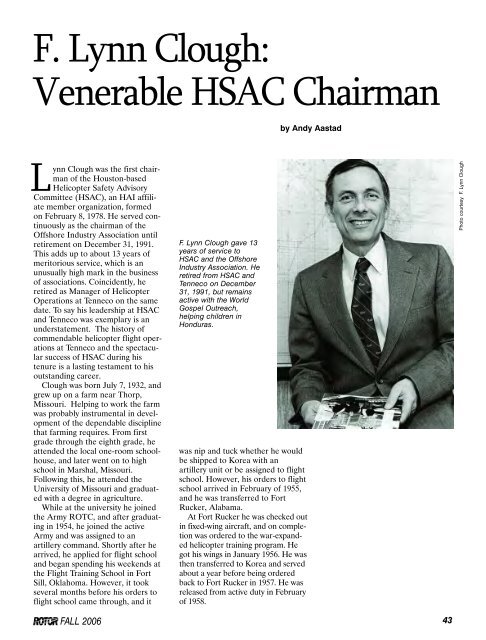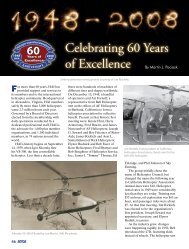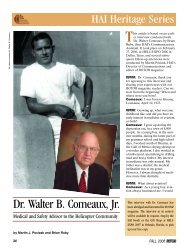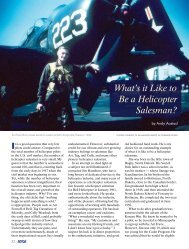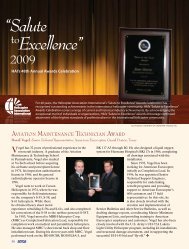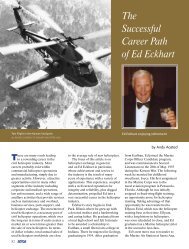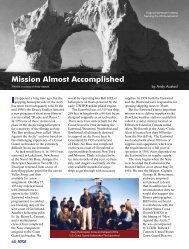F Lynn Clough Venerable HSAC Chairman
F. Lynn Clough: Venerable HSAC Chairman L - Rotor®Magazine
F. Lynn Clough: Venerable HSAC Chairman L - Rotor®Magazine
- No tags were found...
Create successful ePaper yourself
Turn your PDF publications into a flip-book with our unique Google optimized e-Paper software.
F. <strong>Lynn</strong> <strong>Clough</strong>:<br />
<strong>Venerable</strong> <strong>HSAC</strong> <strong>Chairman</strong><br />
by Andy Aastad<br />
<strong>Lynn</strong> <strong>Clough</strong> was the first chairman<br />
of the Houston-based<br />
Helicopter Safety Advisory<br />
Committee (<strong>HSAC</strong>), an HAI affiliate<br />
member organization, formed<br />
on February 8, 1978. He served continuously<br />
as the chairman of the<br />
Offshore Industry Association until<br />
retirement on December 31, 1991.<br />
This adds up to about 13 years of<br />
meritorious service, which is an<br />
unusually high mark in the business<br />
of associations. Coincidently, he<br />
retired as Manager of Helicopter<br />
Operations at Tenneco on the same<br />
date. To say his leadership at <strong>HSAC</strong><br />
and Tenneco was exemplary is an<br />
understatement. The history of<br />
commendable helicopter flight operations<br />
at Tenneco and the spectacular<br />
success of <strong>HSAC</strong> during his<br />
tenure is a lasting testament to his<br />
outstanding career.<br />
<strong>Clough</strong> was born July 7, 1932, and<br />
grew up on a farm near Thorp,<br />
Missouri. Helping to work the farm<br />
was probably instrumental in development<br />
of the dependable discipline<br />
that farming requires. From first<br />
grade through the eighth grade, he<br />
attended the local one-room schoolhouse,<br />
and later went on to high<br />
school in Marshal, Missouri.<br />
Following this, he attended the<br />
University of Missouri and graduated<br />
with a degree in agriculture.<br />
While at the university he joined<br />
the Army ROTC, and after graduating<br />
in 1954, he joined the active<br />
Army and was assigned to an<br />
artillery command. Shortly after he<br />
arrived, he applied for flight school<br />
and began spending his weekends at<br />
the Flight Training School in Fort<br />
Sill, Oklahoma. However, it took<br />
several months before his orders to<br />
flight school came through, and it<br />
F. <strong>Lynn</strong> <strong>Clough</strong> gave 13<br />
years of service to<br />
<strong>HSAC</strong> and the Offshore<br />
Industry Association. He<br />
retired from <strong>HSAC</strong> and<br />
Tenneco on December<br />
31, 1991, but remains<br />
active with the World<br />
Gospel Outreach,<br />
helping children in<br />
Honduras.<br />
was nip and tuck whether he would<br />
be shipped to Korea with an<br />
artillery unit or be assigned to flight<br />
school. However, his orders to flight<br />
school arrived in February of 1955,<br />
and he was transferred to Fort<br />
Rucker, Alabama.<br />
At Fort Rucker he was checked out<br />
in fixed-wing aircraft, and on completion<br />
was ordered to the war-expanded<br />
helicopter training program. He<br />
got his wings in January 1956. He was<br />
then transferred to Korea and served<br />
about a year before being ordered<br />
back to Fort Rucker in 1957. He was<br />
released from active duty in February<br />
of 1958.<br />
Photo courtesy F. <strong>Lynn</strong> <strong>Clough</strong><br />
FALL 2006<br />
43
Bell Helicopter photo via Bob Petite<br />
<strong>Clough</strong>’s early flying with Petroleum Helicopters gave him a unique appreciation of<br />
the challenges met by pilots and crews traveling to and from oil platforms in the<br />
Gulf of Mexico.<br />
Not one to waste time, he applied<br />
for a position at Petroleum<br />
Helicopters in Louisiana, and was<br />
hired in March of 1958. He began flying<br />
offshore in a very early 47 J<br />
model with wooden blades, and also<br />
checked out in one of the early<br />
Alouette II helicopters, which were<br />
being introduced in the Gulf of<br />
Mexico at that time. In September of<br />
1958 PHI sent him to Bolivia, where<br />
he flew a Helio Courier and later a<br />
Dehaviland Beaver. His tour of duty<br />
in Bolivia lasted about 26 months and<br />
was highlighted by a most important<br />
event in his life — he met his lovely<br />
wife Sarita. They were married on<br />
May 26, 1959, and returned to the<br />
states in December 1960.<br />
Back in the states, his family persuaded<br />
him to return to the farm in<br />
Missouri. He worked the farm with<br />
his father for about two years, but his<br />
love of aviation dominated, and he<br />
opted to get back to Louisiana, flying<br />
again for PHI in 1963. Then a friend<br />
from Tennessee Gas Transmission,<br />
which became Tenneco, called about<br />
an opening for a helicopter pilot.<br />
<strong>Clough</strong> applied and was hired on<br />
October 25, 1965, reporting to Al<br />
Hobson, who was Manager of<br />
Helicopter Operations. At that time<br />
Tenneco had only two helicopters,<br />
one in Agawan, Massachusetts, for<br />
pipeline patrol and one in Houma,<br />
Louisiana, for offshore work, where<br />
<strong>Clough</strong> was assigned.<br />
In 1974, <strong>Clough</strong> became Manager<br />
of Helicopter Operations after Al<br />
Hobson retired. At that time, the<br />
helicopter fleet was growing with the<br />
addition of twin turbine BO 105 helicopters.<br />
But to back up a little,<br />
<strong>Clough</strong> tells the story that the fleet<br />
really began to grow when Gardner<br />
Symonds, then <strong>Chairman</strong> of<br />
Tenneco, had flown in an early Bell<br />
206A in 1964, and was impressed.<br />
He later recommended that the 206<br />
should be added to the fleet. I personally<br />
remember the day that Tony<br />
Zuma, Director of Flight<br />
Operations, arrived at the Bell<br />
offices in Hurst, Texas, unannounced<br />
and asked for a salesman. I walked<br />
him back to my desk and he seemed<br />
a little reluctant as he told me “I’ve<br />
got to buy a helicopter.” Their first<br />
206A was assigned to the Tenneco<br />
office in Houston. Later each of the<br />
eight pipeline divisions had one. At<br />
the end of <strong>Clough</strong>’s career, the<br />
Tenneco helicopter fleet had grown<br />
to about 12 BO 105 helicopters.<br />
In 1979, the oil industry experienced<br />
several disastrous offshore<br />
accidents, resulting in the loss of<br />
lives. The growing problem generated<br />
widespread concern and substantial<br />
discussion among the helicopter<br />
operators and the oil industry.<br />
Then, a major accident involving a<br />
Penzoil operation occurred, resulting<br />
in 19 fatalities, when an offshore<br />
crane struck a large turbine helicopter.<br />
This, along with previous accidents,<br />
caused the International<br />
Association of Drilling Contractors<br />
(IADC) to call for a meeting of<br />
applicable helicopter operators and<br />
other parties for a discussion of the<br />
problem and possible action. The<br />
meeting was sponsored by the<br />
Safety Committee of the IADC,<br />
and was held in Houston on<br />
February 8, 1978.<br />
The original participants of that<br />
first meeting, who would become<br />
members of the committee, included:<br />
Jack Piehl (Shell Oil Co.),<br />
Chuck Setzer (Gulf Oil), <strong>Clough</strong><br />
<strong>Clough</strong> (Tenneco, Inc.), Lonnie Nail<br />
(Tenneco Oil Co.), Owen Guidry<br />
(Petroleum Helicopters), John<br />
Brown (Evergreen Helicopters,<br />
Inc.), Jim Grant (Evergreen<br />
Helicopters, Inc.), Don<br />
Groenemann (Evergreen<br />
Helicopters, Inc.), Thomas H.<br />
Marlow (Evergreen Helicopters,<br />
Inc.), James L. Culpepper (Air<br />
Logistics), Ed Seymour (Tenneco,<br />
Inc.), E.E. Rhodes (Mobil Oil),<br />
Herman Moore (Chevron Oil), Park<br />
Jones (Houston Helicopters),<br />
Thomas Howarth (Offshore<br />
Helicopters, Inc.), and James Jay<br />
(Marlin Drilling Co.).<br />
The result of this meeting was an<br />
agreement to work together to promote<br />
improved safety in offshore<br />
helicopter operations, to evaluate<br />
procedures and address specific<br />
operational problems. They also<br />
unanimously agreed to become the<br />
Helicopter Safety Advisory<br />
Committee, affiliated with IADC.<br />
Additionally, recognizing the need<br />
for leadership, <strong>Clough</strong> was elected<br />
chairman of the committee.<br />
Shortly thereafter, a follow-up<br />
meeting was scheduled to set direction<br />
and procedures. For the first six<br />
months of its existence, the dedicated<br />
committee met monthly. After<br />
that, the schedule was changed to<br />
meeting bimonthly, and finally, after<br />
about a year, the quarterly schedule<br />
was adopted and continues today.<br />
Participation in <strong>HSAC</strong> has grown to<br />
about 115 members, including oil<br />
companies, drilling contractors,<br />
service companies, helicopter manufacturers,<br />
and helicopter operators.<br />
Additionally, several branches of the<br />
U.S. government and the U.S. mili-<br />
44 FALL 2006
Photo courtesy F. <strong>Lynn</strong> <strong>Clough</strong><br />
tary participate. <strong>HSAC</strong> also cooperates<br />
with several professional organizations,<br />
including Helicopter<br />
Association International, American<br />
Petroleum Institute, the Offshore<br />
Operations Committee, the<br />
National Fire Protection<br />
Association, and others.<br />
<strong>HSAC</strong>’s accomplishments over<br />
the years are far too numerous to<br />
itemize here. However, they can be<br />
viewed on the <strong>HSAC</strong> Web site, at<br />
www.hsac.org.<br />
As an interesting example of the<br />
hundreds of problems encountered,<br />
there was a startling incident related<br />
by <strong>Clough</strong>. An Air Force B-52<br />
bomber flew under an Evergreen<br />
212, operating in the Gulf of Mexico,<br />
which got everyone’s attention. Then<br />
an Air Force T-38 trainer made a<br />
playful pass at one of the Transco<br />
helicopters. These incidents quickly<br />
prompted an <strong>HSAC</strong> meeting with<br />
the Strategic Air Command, which<br />
resulted in significant operational<br />
procedural changes for the U.S. Air<br />
Force. Suffice it to say that <strong>HSAC</strong> is<br />
alert and responsive to problems offshore,<br />
and is a positive influence for<br />
safe helicopter operations for the oil<br />
industry, not only in the Gulf of<br />
Mexico but also worldwide.<br />
To comment briefly on the scope<br />
of helicopter operations in the Gulf<br />
of Mexico, <strong>HSAC</strong> annually produces<br />
a report on safety statistics, which<br />
can also be seen on www.hsac.org.<br />
<strong>Clough</strong>’s chairmanship at <strong>HSAC</strong> has done much to make flying operations safer in<br />
the Gulf of Mexico. His leadership has been a benefit for everyone involved in flying<br />
operations.<br />
In the latest report on 2005 operations,<br />
it is estimated that a total of<br />
589 helicopters flew about 389,500<br />
hours, carrying 2,625,322 passengers<br />
in the ever-growing offshore Gulf of<br />
Mexico. The report is based on<br />
response from 21 participating helicopter<br />
operators. Helicopter operations<br />
in the Gulf represent a major<br />
slice of total helicopter operations in<br />
the United States.<br />
So, back to <strong>Clough</strong>, who is retired<br />
and living in Conroe, Texas. What is<br />
going on? Well, first <strong>Clough</strong> and<br />
Sarita raised four children, who have<br />
produced 10 grandchildren to date.<br />
That’s enough to keep any grandparent<br />
busy. But <strong>Clough</strong> spends a considerable<br />
amount of time with World<br />
Gospel Outreach. Working primarily<br />
in Honduras, he has made 13 trips to<br />
that country since 1992 in a successful<br />
effort of cooperation with the<br />
organization to improve the lives of<br />
children. They have established an<br />
orphanage, medical, and dental facilities<br />
and a bilingual language school.<br />
They have also arranged for a<br />
halfway house to assist boys and girls<br />
reaching the age of 18, in finding a<br />
job or advanced education. <strong>Clough</strong>’s<br />
primary function with Outreach is<br />
expediting the flow of goods from<br />
the United States to Honduras. He<br />
loads two 40-foot containers a year<br />
for export to the needy. That’s a fulltime<br />
retirement job.<br />
<strong>Clough</strong> has always operated with<br />
a high level of integrity and concern<br />
for his employees and peers. He is<br />
noted for his sincerity, dedication,<br />
and professional approach in both<br />
personal and business endeavors.<br />
Today those attributes are regularly<br />
benefiting hundreds of children and<br />
young people in Honduras.<br />
HAI archives photo<br />
<strong>Clough</strong> is as active today as ever with his efforts reaching out to children in<br />
Honduras. This is typical of his commitment to make things better.<br />
FALL 2006<br />
Andy Aastad is the former Editor of<br />
the Helicopter Market Letters and a<br />
market consultant to the helicopter<br />
industry. He can be reached at 252-<br />
635-5015 or aastad@cox.net.<br />
45


